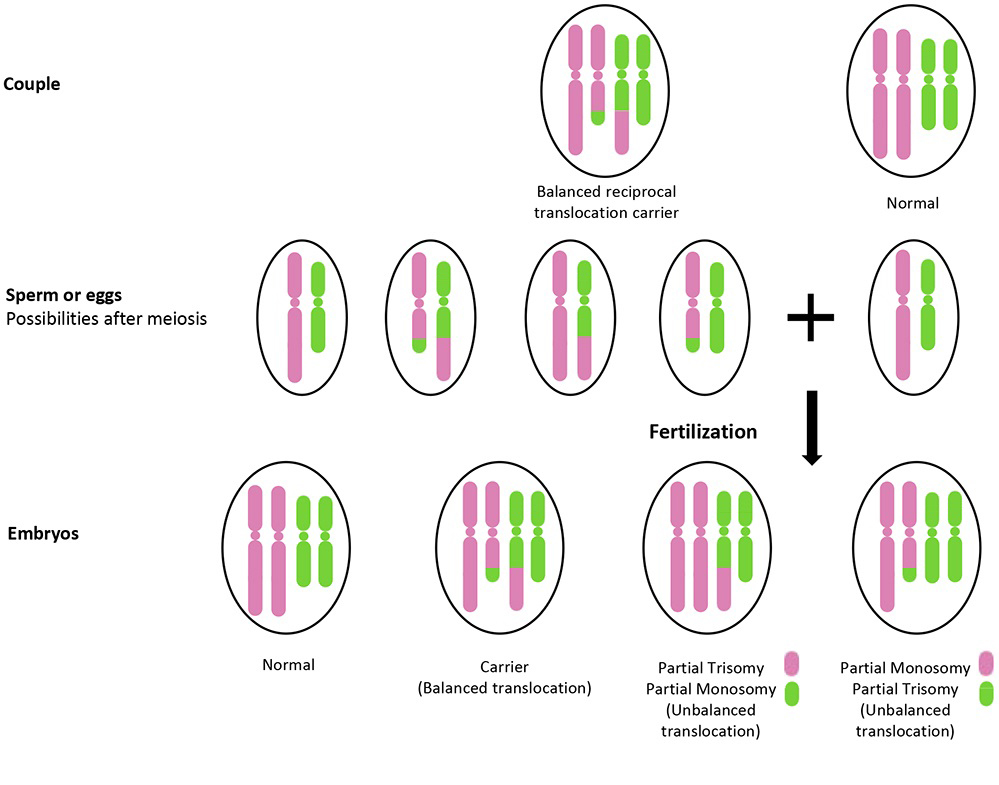Genetic Balance Translocation
A chromosomal translocation or genetically balanced translocation is a condition where a part of the chromosome has broken off and is attached in another location. In simple terms, it means that sections of two chromosomes have switched places. Depending on the circumstances, a chromosomal translocation can be completely harmless, or it can cause serious health… Read More
Top Doctors For Genetic Balance Translocation Treatments
Top Hospitals For Genetic Balance Translocation Treatments
Genetic Balance Translocation
A chromosomal translocation or genetically balanced translocation is a condition where a part of the chromosome has broken off and is attached in another location. In simple terms, it means that sections of two chromosomes have switched places. Depending on the circumstances, a chromosomal translocation can be completely harmless, or it can cause serious health consequences. This balanced translocation affects approximately 1 in 560 individuals. It is one of the less obvious causes of infertility, as it is present in around 3-7% of cases.
When either partner has this balanced translocation, the risk of miscarriage increases from 20% to about 40%. It is also noteworthy that the majority of the individuals with balanced translocation do not have any serious health concerns and are largely unaware of the presence of the condition. It is usually discovered in the process of trying to conceive and carry a pregnancy to term and failing repeatedly. The typical presentation of the condition is a couple that has had multiple pregnancy losses, with their basic infertility tests in assessing the egg and sperm health being normal.

What exactly is chromosomal translocation?
A normal individual’s genetic composition is 23 pairs of chromosomes that are roughly X-shaped. When this individual’s cells divide to create a gamete, that is either sperm or an egg cell, the chromosome should divide in half symmetrically allowing equal portions of the genetic material to be divided into the cells. However, this does not always happen during the division process, and rearrangements often occur.
Once fertilization occurs, the matching chromosomes from the sperm and egg rejoin, creating a single chromosome again. A balanced translocation happens when part of one chromosome breaks off and attaches to a different chromosome. Essentially, a portion of genetic material switches spots. The total number of chromosomes and genetic materials does not change. However, the structure of the chromosome is broken because a portion of it is incorrectly attached.
Individuals carrying balanced translocation can either create embryos with the same balanced translocation, an unbalanced translocation with a gain or loss of genetic material, or a normal set of completely unaffected chromosomes. A balanced translocation and a normal set of chromosomes will allow for normal embryo development, safe pregnancy and live birth. However, an unbalanced translocation will result in pregnancy loss. Research has also shown that if one partner is a carrier of a balanced translocation, approximately a quarter of the embryos will have abnormal genetic makeup.
How is balanced translocation diagnosed?
A balanced translocation is diagnosed through karyotyping. This is where blood is collected from the individual or both partners. The blood is then taken to the lab and analyzed to assess the number and appearance of each chromosome. In the instance that a balanced translocation is discovered, the report will identify the chromosomes that are affected and where on those chromosomes the switching of the chromosomes can be found.
What is the treatment of balanced translocations?
There is no cure for balanced translocations. In most cases, the only symptom or effect of this condition is recurrent miscarriages. Couples that are affected by these conditions will eventually naturally conceive a baby that has a normal genetic makeup and has a successful pregnancy. However, repeated miscarriages can be difficult to handle both physically and emotionally. Repeated miscarriages can lead to some complications like the build-up of scar tissue. Accordingly, couples who have been diagnosed with balanced translocation, and wish to avoid the emotional and physical toll of repeated pregnancy losses may want to explore other sophisticated means that can enable them to carry a pregnancy to term.
Balanced translocation and IVF
While there is no cure for balanced translocation, as it is a part of the individual’s genetic makeup, recurrent pregnancy loss due to the condition can be successfully managed through in vitro fertilization and preimplantation genetic testing for structural rearrangements (PGT-SR). The most commonly used PGT-SR is next-generation sequencing (NGS). The technique aims to determine the embryos that contain the correct amount of genetic material and exclude the embryos that have the incorrect amount of genetic material. By identifying these embryos with the incorrect amount of chromosomes, the chances of miscarriage can be reduced. The technology has gotten quite sophisticated, and a few labs can distinguish between embryos with balanced translocation and those that are unaffected by the condition. The technology is referred to as PGT-SR plus and uses a combination of NGS and Single nucleotide polymorphism (SNP) microarray.

How is it done?
Before starting the IVF process, the PGT lab will usually conduct a case review of the individual or couples’ translocation. This is to ensure that they have all the critical information needed to perform the procedure. There may also be additional consultations, where they meet with a genetic counselor to provide additional information about the case, just to be sure that they have all the information needed. The IVF process begins once the case has been approved by the PGT lab. The IVF process starts with a hyperstimulation of the ovaries; the follicles are then harvested and fertilized. The resultant embryos are then incubated till they get to the blastocyst stage.
A small cell sample is biopsied from them, then the embryos are frozen. The cell samples from each embryo are analyzed at a PGT lab. With the use of NGS technology, the lab can determine the embryos that are affected by the condition. Once the balanced and normal embryos have been identified via PGT-SR, the embryos are then further assessed through preimplantation genetic testing for aneuploidy. This tests for the absence of or gain of entire chromosomes. Most companies guarantee results within ten days. The report is usually forwarded to the couple’s or individual’s doctor, who will then review it with the affected individuals. In that consultation, the best embryos that are available for the frozen embryo transfer are determined.
Summary
For individuals who have had multiple miscarriages due to balanced translocation, or those who have recently been diagnosed with the condition, there are now available options. Karyotype testing can be used to diagnose balanced translocation. IVF with PGT-SR can help pick out the embryos that have the best chances of having a healthy pregnancy.



































